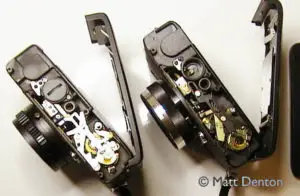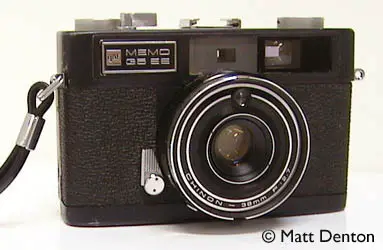- Produced 1970s by Chinon for GAF Corporation
- Film type 135 (35mm)
- Picture size 24mm x 36mm
- Weight 12.2oz (345.9g)
- Lens Chinon Chinonex 38mm 1:2.7-22
- Filter size 46mm
- Focal range 3.4′ to infinity
- Shutter Chinon copy of Copal shutter?
- Shutter speeds B, 1/30-1/650
- ASA 25-500
- Viewfinder coupled rangefinder
- Exposure meter lens mounted CdS with viewfinder needle (aperture and shutter)
- Battery originally 1.3v PX675 mercury
- Hotshoe and PC Sync
- Self-timer
- Fast-action wind lever
Overview
Also sold as the Chinon 35EE, this cool compact rangefinder was made by Chinon for GAF (formerly Ansco). It’s a close copy of my beloved Konica C35 but with a sharp Chinonex lens. Another version was called the GAF Point Five. I’m not sure what if any were the differences between the models apart from a differently styled wind lever and/or top cap. Exposure is set automatically, exactly as on the Konica C35 (and in the same range), you set the lens ring to ‘A’ and that’s it. There is no manual aperture or shutter operation. For flash photography you set the flash guide number on the lens barrel and focusing then is limited to the flash range at that ASA. It’s precisely like the flashmatic system found on the contemporary Minolta rangefinders and the C35, mechanical it may be but it’s practically foolproof.
How close a copy you ask? Here’s what they look like underneath, they’re not exactly alike but so close that you can get the baseplates mixed up… they almost but not quite fit each other, the size is the same but the placement of the batteries and rewind release is slightly off. Chinon on the right, Konica on the left.

My thought is that when Konica stopped making the C35 they licensed the design to OEM Chinon and possibly OEM Cosina as well, as they also had a C35 clone called the Cosina Compact 35S (though not an actual rangefinder). Either that or they were simply close copies owing to the success of the super-compact C35, we’ve certainly seen good examples in the past and in the present of how closely camera companies copy each other’s designs. Still, the bodies are similar enough that the bodies could have been made by a single OEM and then the final product with different top cap and lens barrel could have been made independently, this may be what happened with the Minolta Hi-Matic 7sII and the near-identical Vivitar 35ES which sources indicate was made by Cosina, who also made a model 35EE that had the same 7sII/35ES body and the lens mount of a Konica C35. Did you get all that? Perhaps yould you explain it to me?

Chinon, like Cosina, was a popular OEM japanese camera maker making cameras and lenses both under its own name and also for rebranding under other names like Revue (for Foto-Quelle), Prinz, Sears, and GAF. GAF, or General Analine and Film, was what came of Ansco after that whole business with Nazi Germany, there’s a story for you, I won’t tell it as it’s complicated and confusing, do a Google search or check the library, there is at least one book on the subject. Then there’s the trouble they had with selling asbestos products, class-action lawsuits etc. I preferred to think of them as the View-Master(tm) people and let it go, till I read about the toxic chemicals in the groundwater where those used to be manufactured, still being cleaned up in 2003 in Oregon, right near where Powell’s books is now. Ugh. At least one form of GAF is still around, too, they made the fiberglass composition shingles I bought to patch up my roof!
Chinon is still around too, at the time of this writing attempting to re-engineer itself as a modern digital camera maker. I have to say that for a long time I thought Chinon was a Chinese camera company like the one that makes Seagull TLRs, I had no idea it was Japanese or I would have given it more attention sooner! Sounds bad, I know, but remember I live in the US where most anything that says ‘made in China’ on it is only here because it wasn’t worth paying US wages to manufacture.
Repairs
Replaced CdS photocell. Say what? Well get this, first there was no power to the meter (wiggly like with the C35 I fixed). Then, after cleaning out the nasty battery compartment and double-checking all the wiring (all intact) a battery caused the meter to jump to the highest level and stay there. Covering the meter cell had no effect. Playing with the in-line variable resistor had some effect but the meter still stayed at a constant level. Then I decided to study an online electronics course for a couple days and discovered that CdS cells (photocells) are variable resistors that in the presence of electric current lose resistance in the presence of light. No resistance meant that the full voltage would always arrive at the meter (galvanometer). So I suspected that the CdS cell had been damaged by the leaking mercury battery. Luckily Radio Shack sells little variety packs of photocells for about $3, and one was small enough to be a suitable replacement. Quick snip and solder, we’re back in the game.* Now, the replacement was more sensitive than the original, so I used the variable resistor to ajust the meter voltage till it was nearly in tune with a Konica C35 pointed at the same light. Test roll showed it was right on the money except in low light where it underexposed a stop or so, but with flash was spot-on.
*actually it was a little more work than that, the new photocell was slightly larger in diameter, so I used a hobby knife to whittle off the little retaining walls on the plastic ring on the lens surround, then hot-glued the photocell in place over the hole from behind. Not too much more work!

Also the light seals will need replacing, but they’re intact enough for now.
Tips & Tricks
Not much to say here, set the ring to A and the ASA to the film speed, and you’re good to go. For flash photography set to the GN of the flash. I recommend a compact flash for a camera this size, as long as it can cover around 35-40mm (like the Pentax 160sa), I got some obvious dropoff with the X-14.
Has exposure lock – take a close-up reading from the most important part of your subject, press the shutter release halfway, recompose and shoot. Nice.
Battery was originally a mercury PX675 1.3v, you can use an equivalent inexpensive hearing aid battery or set the ASA to 2/3 the film speed and use a 1.5 silver battery instead. I usually use the hearing aid batteries, they’re basically zinc-air batteries but cheaper as they’re not packaged special for camera buffs 😉 Leave the lens cap on when not using the camera to prolong battery life.
Related Links
- This ‘nifty’ page is the reason I bought the thing. What beautiful sample pics!
- Mon ami francais has the identical Chinon 35 EE
- And Mike has the manual!
